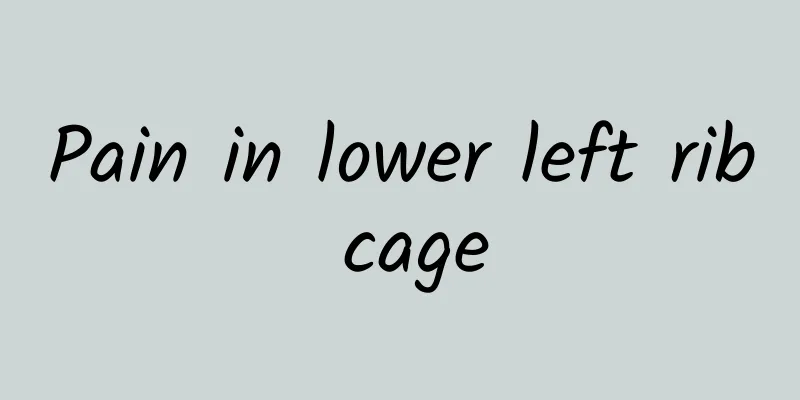Pain in lower left rib cage

|
The dull pain in the lower left ribs is probably caused by a disease called intercostal neuralgia. Resulting in. There are two types of intercostal neuralgia, primary and secondary. Although the symptoms of the two different types of intercostal neuralgia are different, there are still many similarities in the treatment and care process. Below we will introduce you to the relevant knowledge about intercostal neuralgia in detail!1. Common symptoms Intercostal neuralgia is divided into secondary and primary types. Radicular intercostal neuralgia may be caused by diseases such as thoracic vertebra degeneration, thoracic vertebra tuberculosis, thoracic vertebra injury, thoracic vertebra dura mater, tumors, ankylosing spondylitis, etc.; axial intercostal neuralgia may be caused by lesions of the ribs, mediastinum or pleura. Primary intercostal neuralgia is rare. When intercostal neuralgia occurs, pain can be seen radiating from back to front along the corresponding intercostal space in a semicircular shape; the pain is stabbing or burning. The pain gets worse when you cough, take a deep breath, or sneeze. The pain is usually in one nerve on one side. Physical examination revealed obvious tenderness beside the spinous processes of the thoracic vertebrae and in the intercostal spaces; patients with typical radicular intercostal neuralgia had a positive neck flexion test; the distribution area of the affected nerves often showed signs of neurological impairment such as hyperesthesia or hypoesthesia. 2. Treatment Methods Department of treatment: Department of Traditional Chinese Medicine Comprehensive Chinese Medicine Treatment: Drug therapy Rehabilitation Treatment period: 2-4 weeks Cure rate: 85% Commonly used drugs: Yuanhu Pain Relief Capsules and Xiaoyao Pills Treatment costs: The charging standards vary from hospital to hospital. The city's top three hospitals charge about RMB 3,000 to 5,000. Western medicine treatment of intercostal neuralgia 1. Etiological treatment If there is a tumor, surgical resection can be performed; if it is infectious, anti-infection treatment can be used; if it is a viral infection such as herpes zoster, intravenous drip of antiviral drugs such as acyclovir or intramuscular injection of α-interferon can be used. 2. Symptomatic treatment Analgesics or sedatives can be used; B vitamins and vasodilators such as dibazole, niacin and scopolamine; thoracic paravertebral nerve root block, thoracic paravertebral sympathetic ganglion block and intercostal nerve block, etc. 3. Daily care 1. Adjust your daily life and workload, engage in regular activities and exercise, and avoid fatigue. 2. Keep your emotions stable and avoid getting excited and nervous. 4. Diet therapy and health care The diet should be regular and reasonable, that is, mainly high-protein and high-vitamin foods. Choose plant or animal protein with high nutritional value, such as milk, eggs, fish, lean meat, various soy products, etc. Various fresh vegetables, fruits and melons are rich in vitamins and have high nutritional value. |
<<: Buttocks hurt when walking
>>: Pain in the left lower rib cage
Recommend
Can pancakes help you lose weight?
The effect of pancakes on weight loss is not obvi...
Effects of snake venom
There are many poisonous snakes. Poisonous snakes...
Can dysmenorrhea be passed down to daughters?
Many diseases are hereditary. For example, dysmen...
What is internal injury? You can learn about it from both traditional Chinese medicine and ancient times.
Internal injuries and external injuries are two c...
Vulvar bleeding and pain
Vulvar bleeding and pain are mainly caused by vag...
Desensitization surgery
Some male friends feel that their glans is very s...
Which part should be moxibustioned when liver fire is severe?
Moxibustion as a treatment method has a certain t...
How long does it take to treat herpes and who is more susceptible to infection?
Genital herpes is a common sexually transmitted d...
Toxoplasma infection
Toxoplasma infection is a disease that can occur ...
The effects of American ginseng and longan pulp
As we all know, longan and dung bean are fruits t...
What to do if your throat is inflamed, itchy, and you have a cough
In the hospital, the most common diseases are act...
What happens if hemorrhoids are not treated?
I believe that many people have hemorrhoids. As w...
How can I recover quickly from rotavirus infection?
The problem of disease in modern life worries man...
What to eat for depression
Diet therapy is a very popular way of maintaining...
How to identify H-type hypertension?
Many people do not understand H-type hypertension...









